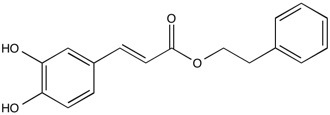CAPE | Inhibits NFkB activation
NMR (Conforms)

Available Options
| Size : | Price | Quantity | |
|---|---|---|---|
| 10 mg | $30.00 | ||
| 50 mg | $54.00 |
CAPE (104594-70-9) is an antioxidant that inhibits NFκB activation and the growth of transformed cells. CAPE inhibits lipid peroxidation and displays antiinflammatory activity. Cell permeable.
References/Citations:
1) Sudine et al. (1993) Caffeic acid phenethyl ester as a lipoxygenase inhibitor with antioxidant properties. FEBS Lett. 21 329
2) Natarajan et al. (1996) Caffeic acid phenethyl ester is a potent and specific inhibitor of activation of nuclear transcription factor NF-kappa B. Proc. Natl. Acad. Sci. USA 93 9090
3) Chiao et al. (1995). Apoptosis and altered redox state induced by caffeic acid phenethyl ester (CAPE) in transformed rat fibroblast cells; Cancer Res. 55 3576
4) Orban et.al. (2000), Caffeic acid phenethyl ester induces leukocyte apoptosis, modulates nuclear factor-kappa B and suppresses acute inflammation; Neuroimmunomodulation, 7 99
NMR (Conforms)
Safety Data Sheet:
Product Data Sheet:
Materials provided by Focus Biomolecules are for laboratory research use only and are not intended for human or veterinary applications. Please note that we do not sell to individuals and that all orders placed by non-research organizations will incur a $20 restocking/refund fee
CAPE (104594-70-9) is an antioxidant that inhibits NFκB activation and the growth of transformed cells. CAPE inhibits lipid peroxidation and displays antiinflammatory activity. Cell permeable.
References/Citations:
1) Sudine et al. (1993) Caffeic acid phenethyl ester as a lipoxygenase inhibitor with antioxidant properties. FEBS Lett. 21 329
2) Natarajan et al. (1996) Caffeic acid phenethyl ester is a potent and specific inhibitor of activation of nuclear transcription factor NF-kappa B. Proc. Natl. Acad. Sci. USA 93 9090
3) Chiao et al. (1995). Apoptosis and altered redox state induced by caffeic acid phenethyl ester (CAPE) in transformed rat fibroblast cells; Cancer Res. 55 3576
4) Orban et.al. (2000), Caffeic acid phenethyl ester induces leukocyte apoptosis, modulates nuclear factor-kappa B and suppresses acute inflammation; Neuroimmunomodulation, 7 99
Related NFκB Products
Download
Calculate the molar concentration, mass or volume in a solution.
Concentration × Volume × Molecular Weight = Mass
Focus Biomolecules • Plymouth Meeting, PA USA • 1-855-FOCUS21
Focus Biomolecules
Plymouth Meeting, PA USA
1-855-FOCUS21
Website Created by Advanta Advertising LLC.

